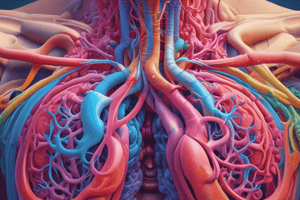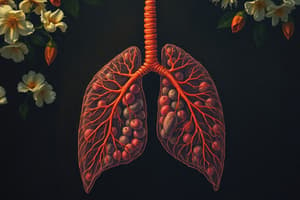Podcast
Questions and Answers
What is the primary function of the respiratory system?
What is the primary function of the respiratory system?
- To filter toxins from the blood
- To regulate body temperature through sweating
- To promote the absorption of nutrients in the intestines
- To supply the body with oxygen and remove carbon dioxide (correct)
Which process involves the movement of air into and out of the lungs?
Which process involves the movement of air into and out of the lungs?
- External respiration
- Pulmonary ventilation (correct)
- Internal respiration
- Transport of gases
What occurs during external respiration?
What occurs during external respiration?
- Carbon dioxide is converted into glucose
- Gas exchange between alveoli and blood happens (correct)
- Oxygen diffuses from the blood into tissues
- Air is conditioned before entering the lungs
How do cells use oxygen during cellular respiration?
How do cells use oxygen during cellular respiration?
What is the primary role of the conducting zone in the respiratory system?
What is the primary role of the conducting zone in the respiratory system?
Which function is NOT performed by the nose in the respiratory process?
Which function is NOT performed by the nose in the respiratory process?
What mechanism does the nasal cavity use to filter air?
What mechanism does the nasal cavity use to filter air?
During which process does oxygen diffuse into systemic capillaries?
During which process does oxygen diffuse into systemic capillaries?
What role do the nasal conchae play in airflow through the nasal cavity?
What role do the nasal conchae play in airflow through the nasal cavity?
Which region of the pharynx serves as a passageway for both food and air?
Which region of the pharynx serves as a passageway for both food and air?
What is one of the primary functions of the larynx?
What is one of the primary functions of the larynx?
How does the trachea prevent collapse during respiration?
How does the trachea prevent collapse during respiration?
What is alveolar ventilation and why is it crucial for gas exchange?
What is alveolar ventilation and why is it crucial for gas exchange?
How does intrapulmonary pressure change during breathing?
How does intrapulmonary pressure change during breathing?
What role does intrapleural pressure play in the respiratory system?
What role does intrapleural pressure play in the respiratory system?
What is the function of surfactant in the alveoli?
What is the function of surfactant in the alveoli?
What is tidal volume?
What is tidal volume?
How is vital capacity determined?
How is vital capacity determined?
What leads to hypoventilation?
What leads to hypoventilation?
What effect does hyperventilation have on carbon dioxide levels?
What effect does hyperventilation have on carbon dioxide levels?
How do partial pressure gradients affect gas movement in the lungs?
How do partial pressure gradients affect gas movement in the lungs?
What is the Bohr effect in the context of hemoglobin and oxygen transport?
What is the Bohr effect in the context of hemoglobin and oxygen transport?
What role does the medullary respiratory centre play in breathing regulation?
What role does the medullary respiratory centre play in breathing regulation?
Which factors influence the activity of the medullary respiratory centre?
Which factors influence the activity of the medullary respiratory centre?
Flashcards
Respiratory System Function
Respiratory System Function
The primary function is to supply the body with oxygen and remove carbon dioxide.
Pulmonary Ventilation
Pulmonary Ventilation
Air movement into and out of the lungs.
External Respiration
External Respiration
Gas exchange between the alveoli and blood.
Internal Respiration
Internal Respiration
Signup and view all the flashcards
Cellular Respiration
Cellular Respiration
Signup and view all the flashcards
Respiratory Zone
Respiratory Zone
Signup and view all the flashcards
Conducting Zone
Conducting Zone
Signup and view all the flashcards
Nasal Cavity Functions
Nasal Cavity Functions
Signup and view all the flashcards
Tidal Volume
Tidal Volume
Signup and view all the flashcards
Inspiratory Reserve Volume
Inspiratory Reserve Volume
Signup and view all the flashcards
Expiratory Reserve Volume
Expiratory Reserve Volume
Signup and view all the flashcards
Vital Capacity
Vital Capacity
Signup and view all the flashcards
Hypoventilation
Hypoventilation
Signup and view all the flashcards
Hyperventilation
Hyperventilation
Signup and view all the flashcards
Partial Pressure Gradient
Partial Pressure Gradient
Signup and view all the flashcards
Nasal Conchae Function
Nasal Conchae Function
Signup and view all the flashcards
Nasopharynx Function
Nasopharynx Function
Signup and view all the flashcards
Oropharynx Function
Oropharynx Function
Signup and view all the flashcards
Laryngopharynx Function
Laryngopharynx Function
Signup and view all the flashcards
Larynx Structure
Larynx Structure
Signup and view all the flashcards
Trachea Support
Trachea Support
Signup and view all the flashcards
Bronchi Support
Bronchi Support
Signup and view all the flashcards
Alveolar Ventilation Importance
Alveolar Ventilation Importance
Signup and view all the flashcards
Study Notes
Respiratory System
- The primary function of the respiratory system is to supply the body with oxygen and remove carbon dioxide.
Processes Involved in Respiration
- Pulmonary Ventilation: Movement of air into and out of the lungs.
- External Respiration: Gas exchange between the alveoli (air sacs in the lungs) and the blood; oxygen enters the blood, and carbon dioxide leaves the blood.
- Transport of Gases: Oxygen and carbon dioxide are transported in the blood between the lungs and body tissues.
- Internal Respiration: Gas exchange between the blood in systemic capillaries and tissue cells; oxygen diffuses into tissues, and carbon dioxide diffuses into the blood.
Cellular Respiration's Role
- Cellular respiration is the process cells use oxygen to convert glucose into ATP (energy).
- Carbon dioxide is a waste product, removed by the respiratory system.
Respiratory and Conducting Zones
- The respiratory zone is where gas exchange occurs (alveoli).
- The conducting zone provides a pathway for air to reach the respiratory zone, conditioning the air through warming, humidifying, and filtering.
Nasal Cavity
- The nose provides an airway, filters and moistens the air, warms it, and houses olfactory receptors.
- The nasal cavity filters air by trapping particles and pathogens using mucus and cilia.
Pharynx
- The pharynx has three regions: nasopharynx, oropharynx, and laryngopharynx.
- These regions act as a passageway for air and food/liquid.
Larynx
- The larynx connects the pharynx to the trachea, conducts air, and houses vocal cords.
- The larynx plays a crucial role in speech production.
Trachea and Bronchi
- The trachea has cartilage rings to prevent collapse.
- The bronchi branch into smaller passages supported by cartilage plates that decrease in size as the airways get narrower.
Alveolar Ventilation
- Alveolar ventilation is the amount of air entering the alveoli per minute. This is essential for adequate gas exchange.
Intrapulmonary Pressure & Atmospheric Pressure
- During inhalation, intrapulmonary pressure drops below atmospheric pressure, causing air to enter the lungs.
- During exhalation, intrapulmonary pressure rises above atmospheric pressure, causing air to exit the lungs.
Intrapleural Pressure
- Intrapleural pressure is always negative relative to intrapulmonary pressure.
- This negative pressure keeps the lungs adhered to the thoracic wall, allowing them to expand and recoil.
Surfactant
- Surfactant reduces surface tension within alveoli, preventing lung collapse, especially during exhalation and when the lungs are at lower volumes.
Lung Volumes
- Tidal Volume (TV): Air moved into and out of the lungs with each normal breath.
- Inspiratory Reserve Volume (IRV): Extra air that can be inhaled beyond tidal volume.
- Expiratory Reserve Volume (ERV): Extra air that can be exhaled beyond tidal volume.
- Residual Volume (RV): Air remaining in the lungs after maximum exhalation.
- Vital Capacity: Tidal volume + inspiratory reserve volume + expiratory reserve volume. Represents the maximum amount of air a person can expel after a maximal inhalation.
Hypoventilation & Hyperventilation
- Hypoventilation: Insufficient alveolar ventilation leading to low oxygen (hypoxemia) and high carbon dioxide levels.
- Hyperventilation: Excessive alveolar ventilation leading to high oxygen and low carbon dioxide levels (respiratory alkalosis).
Partial Pressure Gradients
- Oxygen and carbon dioxide move across the respiratory membrane down their partial pressure gradients. Oxygen diffuses from high pressure in the alveoli to low pressure in the blood; carbon dioxide does the opposite.
Hemoglobin
- Hemoglobin carries most of the oxygen in the blood.
- Temperature and pH affect hemoglobin's affinity for oxygen (Bohr effect).
Medullary Respiratory Centre
- The medullary respiratory center in the brainstem controls the rhythmic breathing cycle.
- It responds to levels of oxygen, carbon dioxide, and pH, and input from peripheral and central chemoreceptors, to adjust breathing rate and depth.
Studying That Suits You
Use AI to generate personalized quizzes and flashcards to suit your learning preferences.




